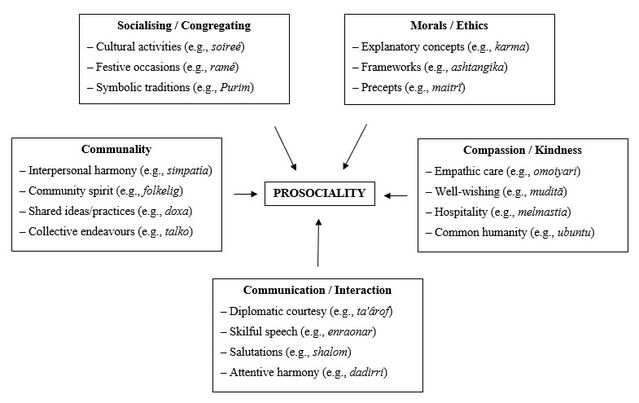Ethics and Morality
What Can We Learn About Pro-Sociality From Other Cultures?
New research on untranslatable words reveals the dimensions of pro-sociality.
Posted December 3, 2018
Redressing Individualism
It is conventional to describe “the West” as relatively individualistic. In more individualist societies, people are liable to be seen, and see themselves, primarily as isolated units, beholden mainly unto themselves.1 This perspective is usually defined in opposition to that of collectivist cultures, of which Eastern countries tend to be used as exemplars. According to theorists, collectivist cultures emphasise the importance of “attending to others, fitting in, and harmonious interdependence.”2 Consequently, their people are considered more likely to “define themselves as aspects of groups” and to “give priority to in-group goals.”3
Mind you, from a critical perspective, this individualist-collectivist distinction could be regarded as the latest incarnation of the “East-West” orientalism discourse identified by Edward Said.4 It homogenises and obscures myriad differences at a local level, neglecting the possibility that “the East” has its own strains of individualism, while “the West” has its own collectivist traditions, and locales that place relatively more of an emphasis on communality, such as Scandinavia.5 Such caveats aside though, the individualist-collectivist distinction has to an extent been corroborated in numerous studies.6
Such trends have various consequences, including well-being. As reflected in the notion of "social capital,"7 social connectedness is integral to flourishing.8 In that respect, it is significant that people in individualist societies are more likely to overlook the importance of connecting and belonging, to their detriment.9 Moreover, this cultural bias extends to psychology itself. Despite being a global endeavour, the field has been strongly influenced by the sway held by Western academic contexts, particularly North America, which reflects the more general hegemony of the U.S. in the 20th century.10 This influence is reflected in the fact that psychology is mainly conducted in the English language. Relatedly, concepts and priorities associated with the West have come to shape our understanding of the person. This includes an overriding tendency towards an individualist perspective, and relatedly, an under-appreciation of the dynamics and importance of the social dimensions of existence.
Expanding Our Understanding of the Social
In the interests of redressing this cultural bias within psychology, I have recently been engaged in a fascinating cross-cultural project: creating a lexicography of ‘untranslatable’ words, those without an equivalent in English, focusing specifically on well-being. Language can be viewed as a form of "experiential cartography," helping us to map and navigate our world.11 As such, untranslatable words are significant, for many reasons. They signify phenomena that one’s own culture has overlooked, but another culture has identified and conceptualised.11 As a result, they assist us in understanding other cultures, offering insights into their values, traditions, and ways of being.12 Moreover, they can give people new concepts with which to articulate and understand their own experiences; for that reason, such words are frequently borrowed by other languages, as they fill a "semantic gap" in that language.13
I began the collection in 2015, and published an initial analysis of 216 words in 2016.14 Since then, the list has expanded to over 1000 words, assisted by generous suggestions from people around the world to my website. My approach has been to analyse the words thematically, using an adapted form of grounded theory, in which theory is inductively derived from data by examining emergent themes.15 Through this, I identified six broad categories of words, and have since conducted specific analyses in relation to each. These are: positive emotions,16ambivalent emotions,17character,18spirituality,19love,20 and – most relevantly here – pro-sociality.21 With respect to each of these categories, it is my hope that untranslatable words can enrich our understanding and appreciation in the psychology of each of these areas. And, with the category of prosociality, this includes the nature and dynamics of our social existence.
The Dimensions of Pro-sociality
In analysing pro-sociality, I identified five broad themes: socialising and congregating; morals and ethics; compassion and kindness; interaction and communication; and communality. In turn, each theme contains various strands, delineating nuances and dimensions encompassed within. These themes are illustrated in the figure below, and beneath that are briefly outlined, together with an example of an untranslatable word, together with a rough description, that helped to form that theme.

The first theme of socialising and congregating addresses the importance people the world over place on gathering together for various reasons. These include:
a) Cultural activities, e.g., soireé (French) – a relatively cultured evening party, often centered around music or conversation.
b) Festive occasions, e.g., ramé (Balinese) – gatherings that are particularly festive, tumultuous and lively.
c) Symbolic traditions, e.g., Purim (Hebrew) – an annual festive occasion commemorating the saving of the Jewish people.
The second theme of morals and ethics reflects the fact that all cultures develop systems of morals/ethics to guide and regulate people’s behaviour. These systems are directly related to pro-sociality since, (a) they are created via pro-social processes, and (b) they concern, in part, prosocial behaviour. Such systems include:
a) Explanatory concepts, e.g., karma (Sanskrit) – a theory of ethical causality (e.g., where skillful actions contribute to positive future mental states).
b) Frameworks, e.g., ashtangika (Sanskrit) – the ‘Noble Eightfold Path’ in Buddhism which adherents are encouraged to follow as a means to spiritual progress.
c) Precepts, e.g., maitrī (Sanskrit) – a principle of loving-kindness that is central to Buddhism.
The third theme overlaps with the previous theme, in that many systems of morals/ethics encourage acts and attitudes of compassion and kindness. These include:
a) Empathic care, e.g., omoiyari (Japanese) – altruistic sensitivity, often with accompanying pro-social action.
b) Well-wishing, e.g., muditā (Sanskrit) – sympathetic or vicarious happiness (i.e., empathy for other people’s positive experiences).
c) Hospitality, e.g., melmastia (Pashto) – an ethical code of the Pashtun people which describes the moral obligation and honour of offering sanctuary to all visitors.
d) Common humanity, e.g., ubuntu (Zulu, and other Bantu languages) – the recognition that all people are kin by virtue of their common human nature.
The fourth theme of communication and interaction concerns harmony within social relationships, and specifically interacting and communicating in skilful ways. This includes:
a) Diplomatic courtesy, e.g., ta'ârof (Farsi) – a culturally important and nuanced form of ritual courtesy (often centred around hospitality, and giving/receiving gifts).
b) Skillful speech, e.g., enraonar (Catalan) – engaging in discussions in a civilised, reasoned manner.
c) Salutations, e.g., shalom (Hebrew) – a term connoting peace, harmony, wholeness, prosperity, welfare and tranquillity, which is used as a greeting/parting salutation.
d) Attentive harmony, e.g., dadirri (numerous Australian Aboriginal languages) – an act and experience of deep, spiritual, contemplative listening.
The final theme of communality transcends the specifics of particular relationships and interactions, and speaks to the togetherness of the group as a whole. This includes ideas such as:
a) Interpersonal harmony, e.g., simpatía (Spanish) – an ethos and act of striving for harmony in interpersonal relationships, and among the group in general.
b) Community spirit, e.g., folkelig (Danish) – a unifying sense of ‘folkish’ commonality, bringing a people together.
c) Shared ideas and practices, e.g., doxa (Greek) – common belief and popular opinion, and shared behaviours and practices.
d) Collective endeavours, e.g., talko (Swedish) – people pitching in together to help attain a common task or goal.
Clearly, much more could be said about each of these words, themes, and the category as a whole. The descriptions above are all partial and imperfect; each word is complex in itself, and arguably warrants an entire paper devoted to it—as indeed has already happened with some, such as simpatía.22 Nevertheless, the analysis hopefully helps to illustrate some of the dynamics of pro-sociality, and may lead to an enhanced understanding in psychology of the nature and importance of our social existence.
References
[1] Geertz, C. (1983). Local Knowledge. London: Fontana Press, p.59
[2] Markus, H. R., & Kitayama, S. (1991). Culture and the self: Implications for cognition, emotion, and motivation. Psychological Review, 98(2), 224-253.
[3] Triandis, H. C. (2001). Individualism-collectivism and personality. Journal of Personality, 69(6), 907-924.
[4] Said, E. W. (1995). Orientalism: Western Conceptions of the Orient. London: Penguin.
[5] Hyyppä, M. T., & Mäki, J. (2003). Social participation and health in a community rich in stock of social capital. Health Education Research, 18(6), 770-779.
[6] Taras, V., Kirkman, B. L., & Steel, P. (2010). Examining the impact of culture's consequences: A three-decade, multilevel, meta-analytic review of Hofstede's cultural value dimensions. Journal of Applied Psychology, 95(3), 405-439.
[7] Bourdieu, P. (1986). The forms of capital. In J. G. Richardson (Ed.), Handbook of Theory and Research for the Sociology of Education (pp. 241-258). New York: Greenwood.
[8] Helliwell, J. F., & Putnam, R. D. (2004). The social context of well–being. Philosophical Transactions of the Royal Society of London. Series B: Biological Sciences, 359(1449), 1435-1446.
[9] Putnam, R. D. (1995). Tuning in, tuning out: The strange disappearance of social capital in America. Political Science and Politics, 28(4), 664-683.
[10] Danziger, K. (2006). Universalism and indigenization in the history of modern psychology. In A. C. Brock (Ed.), Internationalizing the history of psychology (pp. 208–225). New York: New York University Press.
[11] Lomas, T. (2018). Experiential cartography, and the significance of untranslatable words. Theory & Psychology, 28(4), 476–495.
[12] Wierzbicka, A. (1997). Understanding Cultures through Their Key Words: English, Russian, Polish, German, and Japanese. New York: Oxford University Press,.
[13] Lehrer, A. (1974). Semantic fields and lexical structures. Amsterdam: North-Holland Publishing Co.
[14] Lomas, T. (2016). Towards a positive cross-cultural lexicography: Enriching our emotional landscape through 216 ‘untranslatable’ words pertaining to wellbeing. The Journal of Positive Psychology, 11(5), 546-558.
[15] Glaser, B. G. (1992). Basics of Grounded Theory Analysis. Mill Valley, CA: Sociological Press.
[16] Lomas, T. (2017). The spectrum of positive affect: A cross-cultural lexical analysis. International Journal of Wellbeing, 7(3), 1-18.
[17] Lomas, T. (2018). The value of ambivalent emotions: A cross-cultural lexical analysis. Qualitative Research in Psychology. doi: 10.1080/14780887.2017.1400143
[18] Lomas, T. (2018). The roots of virtue: A cross-cultural lexical analysis. Journal of Happiness Studies. doi: 10.1007/s10902-018-9997-8
[19] Lomas, T. (2018). The dynamics of spirituality: A cross-cultural lexical analysis. Psychology of Religion and Spirituality. doi: 10.1037/rel0000163
[20] Lomas, T. (2018). The flavours of love: A cross-cultural lexical analysis. Journal for the Theory of Social Behaviour, 48(1), 134-152.
[21] Lomas, T. (2018). The dimensions of prosociality: A cross-cultural lexical analysis. Current Psychology. doi: 10.1007/s12144-018-0067-5
[22] Triandis, H. C., Marín, G., Lisansky, J., & Betancourt, H. (1984). Simpatía as a cultural script of Hispanics. Journal of Personality and Social Psychology, 47(6), 1363-1375.




